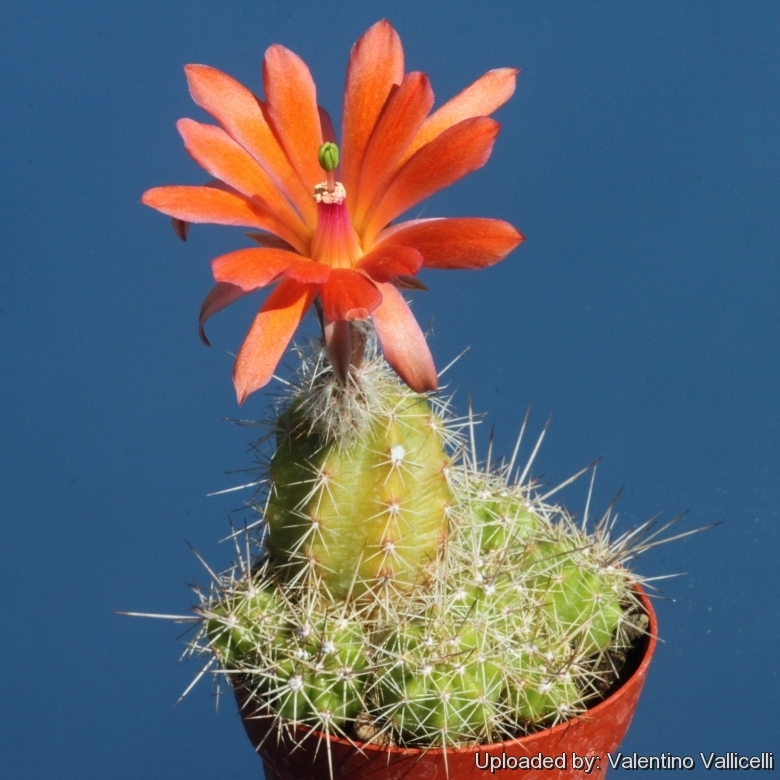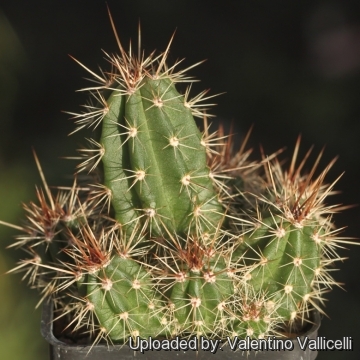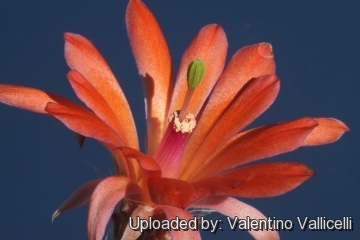= Echinocereus scheeri subs. obscuriensis (A.B.Lau) U.Guzmán
Cactaceae Syst. Init. 16: 17 (11 Oct. 2003) cf. Repert. Pl. Succ. (I.O.S.) 45: 9 (1994 publ. 1995) Remarks: first published in U.Guzmán et al., Catálogo Cact. Mex.: 74 (May 2003), without basionym reference
Accepted Scientific Name: Echinocereus scheeri (Salm-Dyck) Scheer
Bot. Voy. Herald [Seemann] 7-8: 291. 1856 Seem.

Echinocereus scheeri var. obscuriensis (Echinocereus scheeri subs. obscuriensis) Photo by: Valentino Vallicelli
Origin and Habitat: Mexico, Sierra Madre Occidental in the states of Chihuahua (Sierra Charuco, Rio Haciendita, La Bateria, Nabogame, Sierra Obscura) and Sonora (Sierra Saguaribo )
Type locality: Sierra Obscura, Chihuahua, Mexico.
Altitude: 1200-2100 m etres above sea level.
Habitat: Echinocereus scheeriSN|8657]]SN|8657]] v. obscuriensis are sprawling plants growing in rocky slopes and shaded, steep walled and heavily timbered canyons on tops of moss-covered ledges and boulders. In the same area it is possible to find several cactus species like: Echinocereus pectinatusSN|7070]]SN|8503]] v. rubrispinus, Echinocereus stoloniferusSN|21771]]SN|21769]], Echinocereus tayopensisSN|21769]]SN|21771]], Echinocereus polyacanthusSN|8503]]SN|7070]].
Ecology: Echinocereus scheeriSN|8657]]SN|8657]] v. obscuriensis has long, sturdy, orange-red flowers that appear to be adapted for humming-bird pollination. Abundant nectar is provided, as is characteristic of hummingbird flowers, while the absence of a detectable fragrance tends to rule out nocturnal pollination by long-tongued insects such as hawkmoths.
Synonyms:
See all synonyms of Echinocereus scheeri
back
Accepted name in llifle Database:Echinocereus scheeri (Salm-Dyck) ScheerBot. Voy. Herald [Seemann] 7-8: 291. 1856Synonymy: 13
Accepted name in llifle Database:Echinocereus scheeri subs. gentryi (Clover) N.P.TaylorCactaceae Consensus Init. 3: 9. 1997Synonymy: 3
Cultivars
(2):
back
Common Names include:
SPANISH (Español): Colgajito, Choyita
Description: Echinocereus scheeriSN|7070]]SN|8657]] subs. obscuriensis is a morphological or local form of the variable Echinocereus scheeriSN|8657]]SN|8657]] which distinguishes for its stems and spines like those of Echinocereus polyacanthusSN|8657]]SN|7070]] but flowers orange-apricot as in var. scheeri. The presence in habitat of specimens with smaller spines, suggests intermediacy with var. scheeri or var. gentryi. It is a particularly beautiful plant in flower.
Habit: It is a columnar cactus, forming clumps or cushions with densely arranged shoots sometime creeping over boulders and cascading down sides.
Stems: 10-40 cm tall and 2,5 to 4 cm in diameter, upright cylindrical, yellowish-green to dark green.
Ribs: 6-10 .
Areoles: Small.
Radial spines: up 10 short to long, the young spines are yellowish or reddish-brown but turns cream or pale greyish-brown or rapidly.
Central spines: Usually 1, acicular, terete, longer and stiffer.
Flowers: Funnelform on the sides of the stems, 6-10 cm long, huge colourful bright orange-red, with long hairy tube. Tepals orange-apricot to rose magenta inside, paler and less colourful outside. Stigma lobes 9 green.
Subspecies, varieties, forms and cultivars of plants belonging to the Echinocereus scheeri group
Bibliography: Major references and further lectures
1) Edward Anderson “The Cactus family” Timber Press, Incorporated, 2001
2) James Cullen, Sabina G. Knees, H. Suzanne Cubey "The European Garden Flora Flowering Plants: A Manual for the Identification of Plants Cultivated in Europe, Both Out-of-Doors and Under Glass" Cambridge University Press, 11/Aug/2011
3) David R Hunt; Nigel P Taylor; Graham Charles; International Cactaceae Systematics Group. "The New Cactus Lexicon" dh books, 2006
4) “Gentry's Río Mayo Plants: The Tropical Deciduous Forest & Environs of Northwest Mexico” University of Arizona Press, 1998
 Echinocereus scheeri var. obscuriensis (Echinocereus scheeri subs. obscuriensis) Photo by: Valentino Vallicelli
Echinocereus scheeri var. obscuriensis (Echinocereus scheeri subs. obscuriensis) Photo by: Valentino Vallicelli Echinocereus scheeri var. obscuriensis (Echinocereus scheeri subs. obscuriensis) Photo by: Valentino Vallicelli
Echinocereus scheeri var. obscuriensis (Echinocereus scheeri subs. obscuriensis) Photo by: Valentino Vallicelli Echinocereus scheeri var. obscuriensis (Echinocereus scheeri subs. obscuriensis) Photo by: Valentino Vallicelli
Echinocereus scheeri var. obscuriensis (Echinocereus scheeri subs. obscuriensis) Photo by: Valentino VallicelliSend a photo of this plant.The gallery now contains thousands of pictures, however it is possible to do even more. We are, of course, seeking photos of species not yet shown in the gallery but not only that, we are also looking for better pictures than those already present.
Read More... Cultivation and Propagation: In culture Echinocereus scherii is without problems, easy to grow, very attractive and regularly shows its beautiful flowers, if provided with an adequate winter rest period.
Growth rate: It is a relatively rapidly growing species that will make clumps given the best conditions.
Soils: It likes very porous standard cactus mix soil.
Repotting: This plant needs plenty of space for its roots, repotting should be done every other year or when the it has outgrown its pot. Use pot with good drainage.
Watering: It is sensitive to over-watering (rot prone), and needs good drainage. Keep drier and cool in winter. In the summer it need an airy location in bright sun; keep it well watered when it's hot.
Fertilization: Feed with a high potassium fertilizer in summer.
Hardiness: In the winter light, cool, and absolutely dry conditions. Reputedly resistant to frost if kept on the dry side prior to, and during, cold weather (hardy to -7° C or less for short periods of time, USDA Zone 9 to 10). In mild climate they grow well when planted freely outside in well-drained soil.
Exposition: The plant tolerates bright situations which encourages flowering, but is likely to suffer from sun scorch or stunted growth if over exposed to direct sunlight during the hottest part of the day in summer. It may tolerate filtered sunlight or afternoon shade.
Uses: It is an excellent plant for container growing. It look fine in a cold greenhouse and frame or outdoor in a rockery.
Pests & diseases: It may be attractive to a variety of insects, but plants in good condition should be nearly pest-free, particularly if they are grown in a mineral potting-mix, with good exposure and ventilation. Nonetheless, there are several pests to watch for:
- Red spiders: Red spiders may be effectively rubbed up by watering the plants from above.
- Mealy bugs: Mealy bugs occasionally develop aerial into the new growth among the wool with disfiguring results, but the worst types develop underground on the roots and are invisible except by their effects.
- Scales: Scales are rarely a problem.
- Rot: This species is particularly easy and accommodating, seldom suffer of cryptogamic diseases. Rot it is only a minor problem with Echinocereus if the plants are watered and “aired” correctly. If they are not, fungicides won't help all that much.
Propagation: Seeds or cuttings, as it can branch from the base. To make a cutting twist off a branch and permit it to dry out a couple of weeks, lay it on the soil and insert the stem end partially into the soil. Try to keep the cutting somewhat upright so that the roots are able to grow downward.














